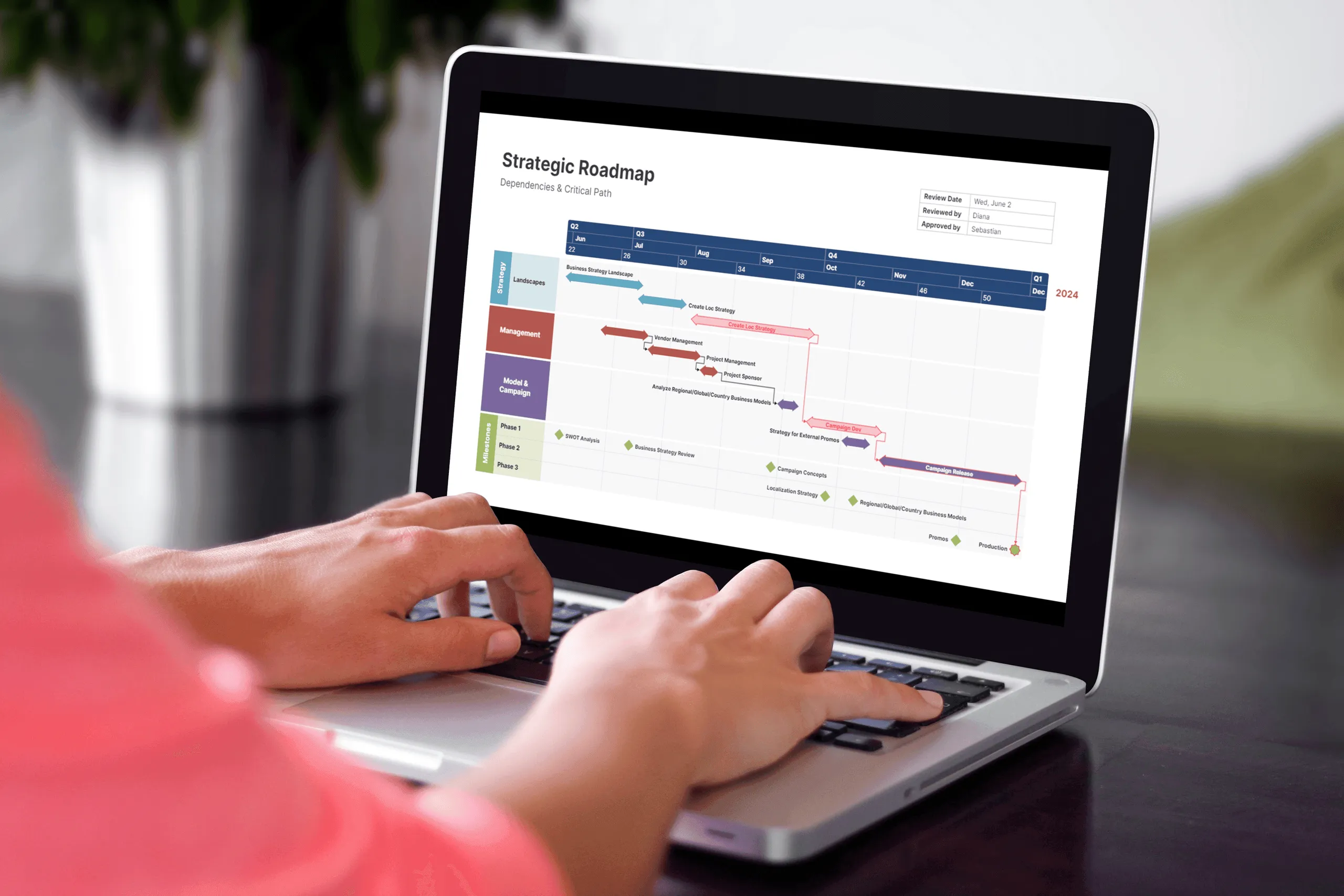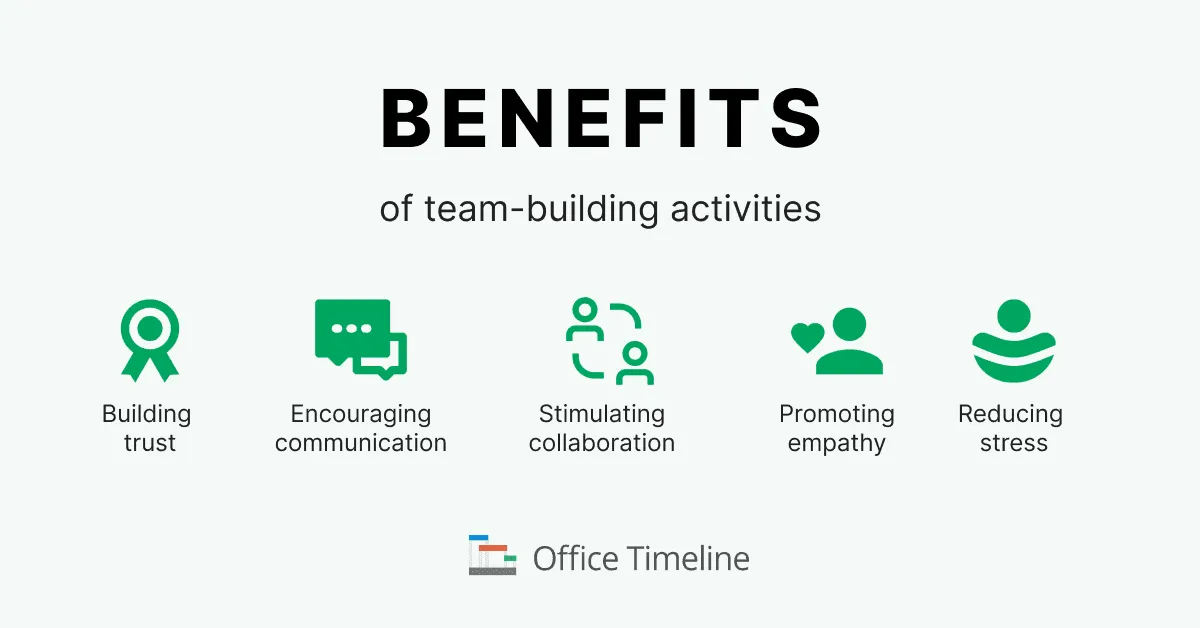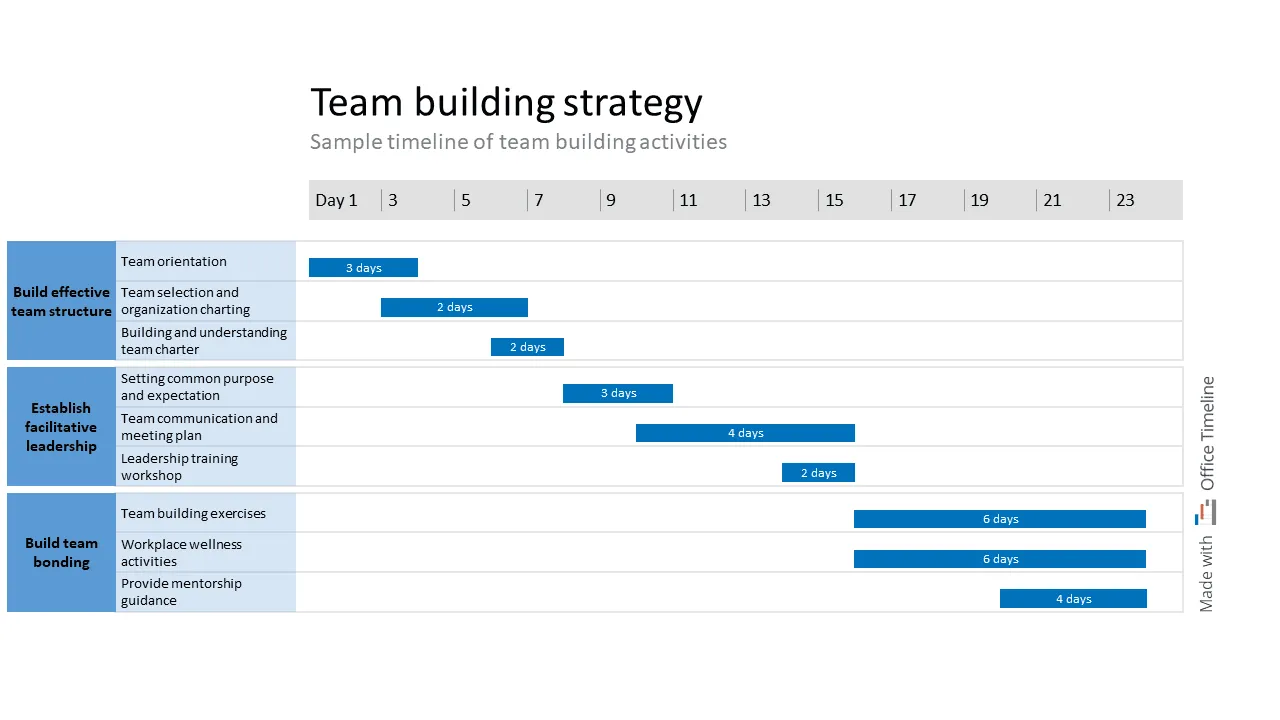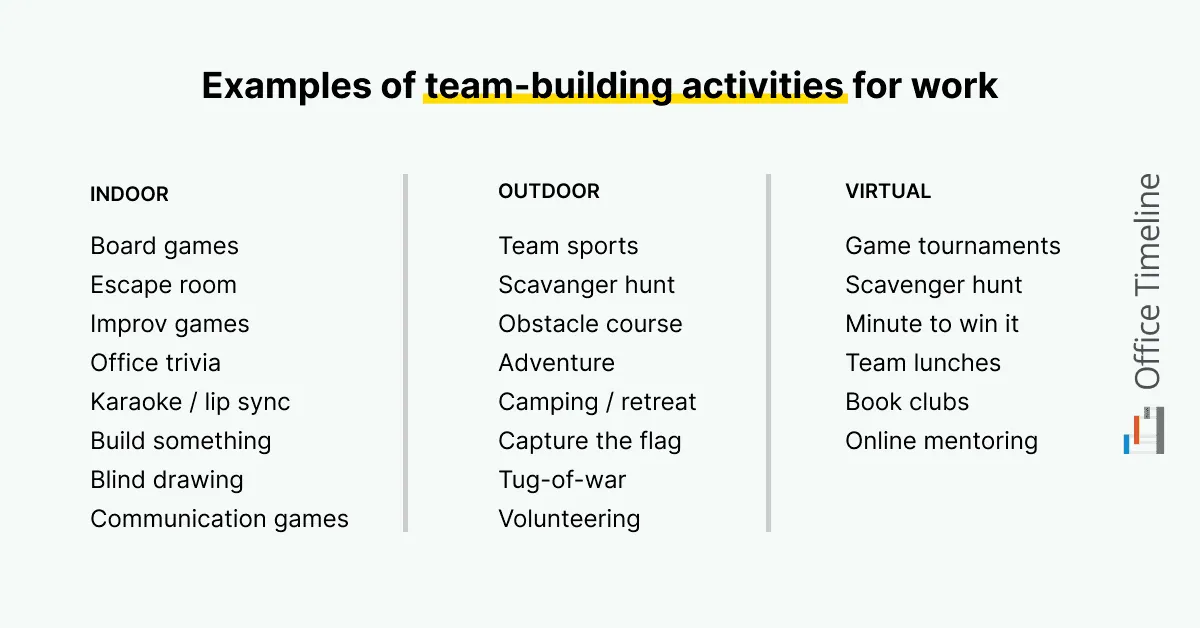How to plan the best team-building activities for work
Explore the best team-building activities for work and learn what to avoid. Download free templates for planning.

Team building activities should be fun, right? Not always, you might say – or maybe not for everyone. It happens when the activities that are supposed to help build a team feel forced, contrived or even uncomfortable for some. And the list goes on: repetitive, irrelevant and cringe. Sounds familiar? Then this blog post is for you.
First, we’ll explore what makes teams tick to understand why some teams work better than others and to be able to identify the tell-tale signs when things are not great and make adjustments when needed. We’ll also look into why there is no such thing as “one size fits all” solution when it comes to team motivators, team building and bonding.
Then, you’ll find suggestions and sources of inspiration for team-building events, planning advice from our team of professionals and some free templates to help you kick-start the planning of your next successful team-building event.
Let’s dig deeper and find out what makes or breaks a successful team building event, and how to fix what doesn’t work.
Brief history of the team-building concept
The concept of team building has been evolving since the early 20th century and has its roots in the field of organizational psychology and human resources.
In the 1920s, Elton Mayo, an organizational psychologist, professor at the Harvard Graduate School of Business Administration and father of the Human Relations Movement, stated that employees are motivated far more by relational and social factors than by monetary rewards or physical/environmental factors.
Mayo conducted an experiment, called the Hawthorne study, at the Western Electric Company Works in the USA to improve industry production. This experiment unveiled the real source of employee motivation, revealing that “social and psychological influences did more to increase output than did changes in wages and hours. This reversed the assumptions long held by managers who believed that economic issues were at the heart of employee motivation.”
Elton Mayo’s work set the foundation for later approaches to team building and team dynamics.
Importance of teams in organizations
Teams are the backbone of an organization. The better the teams work, the higher the organization ranks in performance and the more significant its competitive advantage becomes.
As Amy Randel, professor of Management at the San Diego State University, stated for the Associated Press, “it’s becoming difficult to think of companies that aren’t depending on teams. And usually nothing is more important than having a goal that inspires and organizes people’s efforts.”
Many organizations have moved away from traditional hierarchical structures and towards flatter, more collaborative teams, where individuals work together to achieve shared objectives. Companies now recognize the benefits of collaboration and teamwork, which is becoming increasingly important in modern business due to its global and complex nature.
Top organizations manage to build and maintain high-performing teams by understanding team dynamics, that is, the hidden mechanisms that set them in motion, the relationships and interactions between teammates. Is team-building the secret of high-performing organizations? Probably.
What is a team?
Is a team simply a group of people that find themselves together at some point, acting as individuals? Apparently not. As many researchers have pointed out, the idea of “team” implies cohesion and connection. For example, Jon Katzenbach and Douglas Smith reveal in Harvard Business Review:
Groups don’t become teams because that is what someone calls them. Nor do teamwork values by themselves ensure team performance. So what is a team? […] A team is a small number of people with complementary skills who are committed to a common purpose, set of performance goals, and approach for which they hold themselves mutually accountable. The essence of a team is common commitment. Without it, groups perform as individuals; with it, they become a powerful unit of collective performance.
Why we work in teams
One way or another, most of us belong to a team. When you think of a team, you visualize a group of individuals who work together towards a shared goal, and this can take many forms. For example, you might be part of a sports team, a work team, a volunteer team for a community event, or even a family team that works together to maintain a household. Even as a solo entrepreneur or a freelancer, you are still part of a broader ecosystem that includes clients, collaborators, and other stakeholders. In this sense, you are still part of a team, although a more loosely defined one.
Social belonging is a fundamental human need and refers to the feeling of being connected to others and a part of a group or community. It is rooted in our evolutionary history as social creatures who depend on each other for survival and is an essential aspect of human social and emotional development. From an early age, humans seek out social connections and interactions, including close relationships with family and friends, membership in social groups, and participation in communities.
From individual skills to a supportive team culture
On an individual level, we are always seeking ways of improvement since this is the key to personal and professional growth. But how can individual growth benefit a team? Can an organization thrive based on the independent growth of its individuals? Individual skills are wonderful, but they are valuable to a team only when put together, when individuals commit to a group effort.
When team members strive to improve themselves, the team benefits their individual contribution, and this is favorable to the performance of the team as a whole. Teams can achieve greater success together by creating an environment that encourages personal improvement. But personal improvement and growth cannot benefit a team without the existence of a supportive team culture.
A supportive team culture is one that includes conditions for clear communication, a growth mindset, continuous learning opportunities, and recognition and reward for personal growth. In such an environment, each member’s strengths are leveraged to achieve the team’s goals. Thus, a diverse range of perspectives emerges, increasing creativity and work quality.
In a nutshell, a sense of belonging and cohesion within a team can help unlock the full potential of each individual team member, and lead to better team performance overall. In a supportive team culture, where team members feel a strong sense of connection and belonging to the team, they are more likely to work collaboratively, trust each other and support growth and development for everyone.
Google’s Project Aristotle: a study on team successfulness
So far, we’ve discussed why collaboration is crucial in a team. But this thinking model was not always embraced even by the most successful companies. Some time ago, Google top executives believed that building the best teams meant bringing together the best individuals, but without really studying the team phenomenon. This was until they started Project Aristotle (its code-name was a tribute to Aristotle’s quote, “the whole is greater than the sum of its parts”) with the goal to understand team effectiveness and determine why some teams encountered difficulties while others thrived.
Project Aristotle’s researchers conducted an extensive review on around 50 years of academic studies looking at how teams worked. They examined team structure and dynamics from every possible angle, from analyzing people’s typologies and interests to motivators and rewards, from the frequency of socialization events outside the office to similitudes in hobbies and educational backgrounds, even questioning whether it was better for all teammates to be extroverts or all of them to be introverts. They also took into account teams’ age (for how long teams stayed together) or if there was any impact generated by gender balance.
As thorough as the studies were, the researchers could not find relevant patterns or evidence that team composition makes any difference. The breakthrough proved to be when the researchers encountered the concept of psychological safety in academic papers.
Psychological safety is a concept in psychology, which, as described by Harvard Business School professor Amy Edmondson in a study published in 1999, designates a “shared belief among team members that the team is safe for taking interpersonal risks”. This idea is often referred to in a colloquial way as traits such as “conversational turn-taking” and “average social sensitivity”.
In short, psychological safety is having an environment of trust, respect and acceptance in a team, where individuals feel safe expressing their ideas and being authentic. Project Aristotle revealed that psychological safety was the most important factor for making a team successful. Teams need to be able to establish psychologically safe environments.
However, identifying the issue does not solve it. Establishing a psychologically safe environment can be difficult for many teams. People are often busy and there needs to be clear guidelines. Additionally, many may not be comfortable talking about feelings. The challenge is to find a way to make communication and empathy (key to forming connections) into a process which can be easily implemented.
Benefits of team-building activities
Team building could be a “gold mine” for an organization. The reason is simple: team building is a process that helps a work group become a cohesive unit by promoting trust, support, and respect among its members. This objective is achieved through a range of activities designed to improve social relations and clarify roles within teams, often involving collaboration on tasks and projects.
Among the benefits, companies see almost every time a significant improvement in creating psychologically safer environments and a growth in collective intelligence, which represents an index of general team capability.
Team-building activities promote psychological safety
As we’ve stated above, psychological safety is the belief that one can speak up, take risks, and share ideas without fear of negative consequences. When team members feel psychologically safe, they are more likely to speak up and contribute to discussions, and this leads to better teamwork and performance.
Team-building activities promote a psychologically safe environment, creating a sense of belonging at the same time. And here is how:
- Building trust. During team building, team members get to know each other better and build trust, which is essential for creating a psychologically safe environment.
- Encouraging communication. According to a study published in Administrative Science Quarterly, team building activities that encourage open communication, feedback, and active listening can improve psychological safety within the team.
- Stimulating collaboration. Team members learn how to work together more effectively, leading to a sense of collaboration and shared purpose.
- Promoting empathy. Empathy and understanding are promoted, leading to a more supportive and inclusive team environment.
- Reducing stress. If done right, team building activities should help to reduce stress and create a more positive and enjoyable work environment.
Team building activities help improve collective intelligence
Team building activities that involve problem-solving and decision-making can also contribute to the development of collective intelligence within the team. Such activity types have been shown to enhance the cognitive abilities and effectiveness of teams.
What is collective intelligence? According to experience and a scientific study from 2010, and contrary to what some would expect, a team’s success is not entirely ensured by the individual intelligence and achievements of the teammates. What distinguishes the successful teams from the dysfunctional ones is how team members treat one another.
In other words, successful teams have a “general collective intelligence factor”, which “is not strongly correlated with the average or maximum individual intelligence of team members but is correlated with the average social sensitivity of group members”. Bottom line, when done right, team-building can be an essential fuel for a company, strengthening relationships, breaking down communication barriers, building trust, and addressing conflicts. It helps team members better understand each other’s strengths, weaknesses, and working styles, and create a sense of camaraderie and mutual respect.
Team-building planning and resources
So far so good, but how do you make it happen? How do you organize a team-building event that your team won’t hate? What should you keep in mind when planning? We’ve put together a few best practices so you can get started right away.
1. Get input from your team
First of all, do you think of how people feel about the idea of team building in general and about your planned event in particular?
Opinions vary, but they are in three main categories. Some people will see team building positively as a fun and engaging way to build relationships, improve collaboration, and get to know their colleagues on a more personal level. Others see it as a waste of time, forced or awkward.
They may feel uncomfortable participating in certain activities or may feel that they are not valuable or relevant to their work. And some may have a more neutral perspective, seeing team building events as part of the job that may or may not be enjoyable or useful, but they are willing to participate.
Ask teammates what types of team building activities they would enjoy and what they would not like. This will help you choose activities that align with their interests and preferences. Also, when people feel that their opinions and preferences are valued, they are more likely to participate and be invested in an activity.
2. Choose activities
- Choose activities that are inclusive. Avoid activities that may make some employees uncomfortable or feel excluded. Choose activities that everyone can participate in, regardless of age, physical ability, or personal interests.
- Choose fun activities. People are more likely to engage and participate if they are having a good time.
3. Consider time
- Keep it short and sweet. Avoid team building events that are too long or too demanding. Choose activities that can be completed within reasonable timeframes and that do not require too much physical or mental exertion.
- Allow for downtime. Provide opportunities for employees to relax and socialize during the event.
4. Draw a plan
Drawing a plan for a team-building event should be a good idea because it helps clarify objectives and ensure that the event is well organized. A plan also helps you track the steps, identify potential challenges, communicate event details to team members and evaluate the success.
Here is what you could include in a plan for a team building event:
- Objectives. Define the goals and objectives of the team building event. For example: improving communication, enhancing problem-solving skills, boosting morale.
- Budget. Set a budget for the event. Take into account costs associated with venue, materials, activities, etc.
- Date and time. Determine the date and time of the event. Check the availability and schedules of team members. If there are multiple activities that extend on more than one day, it would be useful to have timelines for them.
- Activities. Choose activities that align with the objectives of the event, and that are fun, inclusive and enjoyable for all team members.
- Venue. Select a venue that is appropriate for the type and size of the event, and that meets the needs and preferences of the team.
- Facilitation. Consider the need for a facilitator to guide the activities and ensure that the objectives are met.
- Logistics. Determine the logistics of the event, such as transportation, meals, and accommodation, if necessary.
Also, keep these things in mind to make sure your event is successful:
- Communicate the details of the event to team members in advance.
- Provide clear instructions and information. Make sure to include information about the objectives, activities, logistics, and any necessary preparation or expectations.
- Gather feedback from team members to improve future events. Identify areas for improvement.
Planning tools for team-building events
With a planning tool, things get easier and you can start planning in no time. It helps ensure that all necessary tasks are completed and provides a clear overview of the event progress.
You can use event management software for task management, scheduling, and budget tracking or project management tools that can be used to create a project plan and assign tasks to team members. There are many options, but many of these tools can be rather expensive, time consuming and difficult to use.
Our recommendation is Office Timeline, a lightweight PowerPoint add-in that automatically generates timelines and roadmaps, saving you hours of work. By grouping and centralizing tasks in swimlanes and automating processes, our planning tool facilitates tracking and costs control, and can improve efficiency in minutes, not hours. Easily start planning your team-building event and take advantage of the full benefits of its most advanced edition with the free trial.
Make timelines in PowerPoint
Create your visual project plans in minutes with Office Timeline.

Free team-building templates for better planning
Here are our suggestions for templates to start planning in no time. Each template is designed in PowerPoint and perfected with Office Timeline to help plan successful team-building events.
You can download these templates for free as PowerPoint files and customize them to fit your team-building plans. You can modify them either manually by moving the shapes on the PowerPoint slide or automatically using the free trial offered by Office Timeline. Use the templates to monitor progress and manage resources.
1. Team-building event template
Explore this PowerPoint template built with Office Timeline to help you plan your team-building event from scratch. It contains the main stages of planning organized in swimlanes and includes useful information like percent complete for each task. You can customize colors to show status and identify blockers.
2. Team-building strategy template
This simple PowerPoint template uses Office Timeline’s swimlane functionality to present the major steps required in building an effective strategy for your team-building activities in just four weeks. You can easily arrange tasks with a drag & drop and show task duration for a quick overview of allocated time.
3. Team-building day template
Use our Gantt chart template to plan your team-building event down to hours and minutes. You can conveniently display tasks on the left and color-code them to show which activities are done in teams or individually. Since it’s built in PowerPoint with Office Timeline, you can easily share with everyone involved.
Examples of team-building activities for work
Some team-building activities are popular because they provide an opportunity for team members to get to know one another better and work together in a fun and engaging way. They can also help break down barriers between people and encourage them to see each other in a new light.
Additionally, these activities can boost morale and create a positive and enjoyable work environment.
The dos and don’ts of choosing team-building activities
Unfortunately, sometimes not everyone in a team enjoys taking part in team-building activities, and this can have objective causes. Some feel that team building is mandatory, and others just feel anxiety and discomfort towards some activities.
Among the strategies to make sure that the activities are inclusive, engaging, and enjoyable for everyone involved are these:
- Encourage participation without making it mandatory, so employees don’t feel forced or coerced into participating.
- Choose activities that align with your team’s interests and preferences.
- Offer a diverse range of activities that cater to different interests and abilities.
- Ensure that activities are inclusive and don’t create discomfort or anxiety for any employees. Activities should be enjoyable and engaging, rather than feeling like a chore or work task.
- Make sure that everyone has an equal opportunity to participate and contribute to the activity.
- Solicit feedback from team members after the activity to learn what worked well and what could be improved for future events.
The best idea to ensure the success of your next team-building event is to check with your team while in the process of planning it. To make it easier for you to choose the right activity, here’s a quick overview of the collection of games we’ve rounded up in this article:
Let’s have a closer look at these suggestions.
Indoor team-building activities
These are the type of activities that can be chosen when outdoor activities are not feasible, such as during extreme weather conditions or if there is limited space or facilities, but a team can choose them also when they want to improve teamwork skills in a controlled and comfortable environment.
Here are some examples of indoor team-building activities:
Board game tournament
You can split the teams into groups to compete against each other in a board game tournament. The winning team takes the top prize, but don’t forget to set aside smaller rewards for the runners-up or various awards that make the activity enjoyable (e.g., “best dressed team”, “loudest team”, “most creative team”).
Escape room challenge
This is a fun and challenging indoor activity where team members must work together to solve puzzles within a set amount of time. The goal is to find the solution and escape from a locked room in under the set amount of time.
Improv games
- “Yes, and”: Participants take turns making statements, and each statement must begin with “yes, and” followed by an idea that builds upon the previous statement.
- One-Word-at-a-Time: Teammates take turns adding one word to a sentence to create a story. Each person adds one word to the story at a time. The game promotes creativity, active listening, and collaboration skills.
- Storytelling: Teammates take turns telling a story. Each person contributes a sentence or phrase to build the narrative. Participants must work together to create a coherent and engaging story.
Office trivia
Create a trivia game about your workplace (or industry). This should be a quiz game that focuses on questions related to the history of the company, company policies, current events in the industry, or fun facts about the workplace. You can split the teams into groups to compete against each other. This can promote communication, knowledge-sharing among team members and learning about the workplace.
Karaoke or lip sync battles
Team members take turns singing or lip syncing to popular songs in front of their colleagues. These activities can help break the ice and promote a sense of camaraderie among team members and can also help team members overcome shyness or stage fright while having fun and letting loose.
Build something
Challenge teams to build something together, like a tower or bridge, using limited resources. This can help improve problem-solving skills.
Blind drawing or communication games
- Blind drawing: A team member describes a picture to others who then draw it blindly.
- Telephone: Messages are passed from person to person by whispering in their ear and the final message is compared to the original.
Outdoor team-building activities
Outdoor team-building activities offer a change of environment and a chance to experience nature. This can help relieve stress and increase well-being. They also provide opportunities to practice problem-solving, leadership, and communication skills in a dynamic and unpredictable setting, while enjoying the outdoors. Finally, outdoor activities can help improve team members’ physical fitness and build resilience. Fresh air and beautiful scenery are always healthy and excellent morale boosters.
Some of our favorite outdoor team-building activities are:
Outdoor sports activities
Organize sports activities such as softball, soccer, or volleyball. These activities promote physical fitness while helping build teamwork and collaboration skills.
Scavenger hunts
You can plan a scavenger hunt in an outdoor setting where team members can work together to solve clues and complete challenges.
Obstacle courses
Set up an obstacle course with physical challenges such as rope courses or climbing walls.
Adventure activities
Adventure activities like kayaking, canoeing, or zip-lining provide a lot of fun and exciting experiences.
Camping or retreats
Team-building retreats or camping trips are great for teams to spend time together in a relaxing environment. They can also participate in activities like hiking, fishing, or outdoor games.
Team-building games
Play outdoor team building games like “capture the flag” or “tug-of-war” to promote teamwork, communication, and collaboration skills.
- Capture the flag: Two or more teams compete to capture each other’s flag while defending their own. The game is typically played outdoors and requires strategic thinking, communication, and teamwork to win. The objective is to capture the flag and bring it back to the team’s base without being tagged or caught by the opposing team.
- Tug-of-war: Two teams compete to pull a rope in opposite directions. The objective is to try to pull the other team over a center line or into a marked area on the ground. This game promotes teamwork and physical coordination while providing a fun and competitive atmosphere.
Volunteering activities
Outdoor volunteering activities such as trail cleanups, park restoration, or community gardening help build teamwork skills while also giving back to the community.
Remember to choose activities that are suitable for your team’s abilities and interests, and make sure to provide appropriate safety measures and equipment for any physical activities.
Virtual team-building activities
In the current remote, virtual work environment, when teams are scattered around the globe, virtual team-building activities are a great way to improve teamwork. They are a good solution for cases when there is a limited budget or time for team-building events as well, or when seasonal factors make in-person activities impossible.
Here are some of our favs:
Online game tournaments
You can play trivia, chess, or card games in the form of tournaments. This can help build teamwork and communication skills while having fun.
Virtual escape room challenges
To escape from a virtual locked room the teams need to work together to solve puzzles within a set amount of time.
Virtual team-building challenges
You could create a virtual scavenger hunt or a “minute to win it” challenge.
- Virtual scavenger hunt: Team members are given a list of items to find or tasks to complete within a set time frame using items in their home or office, without bringing anything from outside.
- Minute to win it: Team members compete in a series of timed challenges using household items or office supplies. The team member who completes the most challenges in one minute wins the game.
Virtual team lunches
Schedule virtual team lunches where team members can socialize and get to know each other better.
Virtual book clubs
In this virtual club, team members can discuss a book and exchange ideas.
Virtual volunteering activities
Team members can choose to participate together in virtual volunteering activities such as online mentoring.
The right virtual team-building activities are only those that fit your team’s needs and preferences and their work environment. For the success of your event, make sure, as always, that everyone is comfortable and engaged in the activity.
Final thoughts on team-building gains and pitfalls
The success of a company is directly linked to the functioning of its teams. The value of a team that operates effectively surpasses the combined abilities of its individual members. Therefore, team building can be a valuable method for enhancing team cohesion, which can lead to improvements in a company’s performance and culture.
However, to achieve success in team building, careful planning and execution is essential. When planning, it is important to choose activities that align with the team’s interests and goals, and to be mindful of any potential challenges or pitfalls, such as activities that are too physically or mentally demanding or that exclude certain team members.
This requires a thoughtful and strategic approach that prioritizes the needs and preferences of all team members and can be really challenging. Using a software event manager can facilitate planning and tracking of the event.
Free PowerPoint timeline maker
Make planning a breeze with Office Timeline.

Frequently asked questions about team-building
Here are the answers to some FAQs related to team-building activities:
Team building can be a powerful tool for improving the performance and culture of a company. Team-building activities can boost morale and help create a positive work environment while promoting collaboration, communication, and problem-solving skills among team members.
These are some of the benefits that are the result of team-building efforts:
- Improved communication. Employees communicate more effectively and openly. This helps them better understand each other’s strengths and weaknesses, and improves collaboration.
- Better problem solving. Team building exercises often involve problem-solving challenges that require employees to work together and use their collective skills to find solutions. These exercises can help build critical thinking skills and teach employees how to work together to overcome challenges.
- Enhanced creativity. By encouraging outside-the-box thinking, team building exercises can induce innovative ideas and solutions.
- Reduced turnover and increased motivation. Team building exercises can help create a positive work environment. When employees feel like they’re part of a team and that their contributions are valued, they are more likely to be motivated and engaged. At the same time, they’re more likely to stay with the company long-term.
There are many popular team-building activities that companies use to help improve communication and collaboration. Here are five examples:
- Scavenger hunt. Divide employees into teams and send them on a scavenger hunt around the office or outside. Skills to build: teamwork, communication, problem-solving
- Trust-building activities. Activities like trust falls, blindfolded obstacle courses, and building human pyramids can help build trust and improve communication.
- Group problem-solving activities like escape rooms, brainstorming sessions, and puzzle challenges can help employees learn to think creatively and work together to find solutions.
- Team lunches can be a simple but effective way to build camaraderie and improve communication. When employees have the chance to get to know each other outside of work, they’re more likely to feel comfortable collaborating and communicating effectively.
- Volunteer work. Volunteering as a team can be a great way to build morale and give back to the community. Activities like volunteering at a local food bank, cleaning up a local park, or helping out at a charity event can help build teamwork, communication, and a sense of purpose.
The effectiveness of these activities depends on the needs and goals of your team, so it’s important to choose activities that are tailored to your specific situation.
Here are a few examples of team-building activities that work well for small groups:
- Icebreaker games. Icebreaker games are a great way to get a small group to start communicating and working together. Examples include two truths and a lie, never have I ever, and question games.
- Team lunch or coffee. A simple way to build relationships within a small team is to have lunch or coffee together. This is an opportunity for team members to get to know each other on a more personal level and learn about each other’s interests and backgrounds.
- Escape room. A small group can work together to solve puzzles and escape the room within a set time limit.
- Outdoor activities. Outdoor activities, such as hiking, kayaking, or rock climbing, stimulate communication skills, and help build trust in a new, fun and challenging environment.
- Office games. Small groups can play games like trivia, board games, or card games during lunch breaks or after work. These games help to break down barriers and encourage team members to get to know each other better.
Remember, the key to success is to search for activities that suit the interests and preferences of your team members. This will increase the probability of choosing activities that will be engaging and enjoyable for everyone.
Team-building activities for remote teams are designed to facilitate communication, build relationships, and build a sense of community among team members.
Here are some ideas for remote team-building games:
- Virtual escape rooms. Escape rooms are a popular team-building activity that can be adapted to a virtual setting, requiring teams to work together to solve puzzles and escape within a set timeframe.
- Online board games. Many classic board games, like Monopoly and Risk, have been adapted for online play, allowing remote teams to bond over some friendly competition.
- Collaborative challenges. Setting challenges that require team members to work together, like creating a digital art project or writing a story together, can enhance trust and create a sense of community among remote teams.
The key is to choose activities that are engaging, fun, and promote teamwork and communication.
Team building activities are supposed to be funny and, but some ideas will simply make you burst out laughing. Get ready to chuckle!
- “Don’t Laugh” Challenge. Easy-peasy! Take turns telling jokes and see who can keep a straight face the longest. The loser has to wear a ridiculous hat for the rest of the day!
- Reverse Charades. In Reverse Charades, one person guesses while the rest of the team acts out the clue. It’s like watching a silent movie, but with a bunch of wacky characters!
- Office Olympics. Athletes in the office? Done! Set up some silly challenges, like office chair races or paper clip javelin, and see who comes out on top. Just make sure HR doesn’t catch you!
These fun ideas will spice up your work day and help your team bond in a whole new way.
You can think of the types of team-building activities from the perspective of location or that of goals.
- Location-based activities can be: indoor, outdoor, location-specific or virtual.
- Goal-specific activities are usually designed to stimulate relationship building or to make use of specific skills in a fun way. Among such activities are personality tests, communication games, team workouts, community service and volunteering, company retreats activities, problem solving games, and so on.
Icebreakers are great for helping teammates get to know each other and break down barriers. Here are some of the best icebreaker ideas for team building:
- Two Truths and a Lie. This is a classic and it works well for teams of all sizes. Each person introduces themselves and shares two true statements and one false statement about themselves. The others have to guess which statement is the lie.
- Name Game. The name game involves going around the room and saying your name, followed by a word that starts with the same letter as your name. For example, “My name is Sarah, and I like salad.” This game is great for helping team members learn each other’s names and get to know a little bit about each other.
- Would You Rather. This game involves asking questions that require participants to choose between two options (What would they rather do/have/choose?). It can be a fun way to get team members to talk and laugh together.
These are just a few examples, to help you make an idea. The best icebreakers are fun and allow team members to get closer to each other in a relaxed and comfortable setting.
Team building activities are a good idea because they help create a positive and motivated environment, encouraging innovation and problem-solving and increasing job satisfaction and performance. Also, team building provides an opportunity for team members to get to know each other and build relationships and trust. This can improve team communication and collaboration. They can also help reduce stress and improve employee morale, leading to a more productive and engaged workforce.
People working in remote teams can get to know each other wherever they are. There are many team building games for remote teams, from simple games to complex programs. Find inspiration in our favs below and connect with your remote team:
- Storytelling. One team member starts a story, and each team member takes turns adding to it. The story can be as serious or as silly as you like.
- Virtual Trivia. You can create a quiz or use an online platform to host a virtual trivia game. Choose topics that everyone on the team is familiar with.
- Two Truths and a Lie. In this game, each team member shares two true statements about themselves and one false statement. The rest of the team has to guess which statement is the lie.
- Virtual Scavenger Hunt. Create a list of items or tasks for the team to complete or find, such as finding a red object in their workspace or creating a team cheer. The first team to complete all the items wins.
- Virtual Charades. On an online platform or video conferencing software, play a virtual game of charades. Choose a category, such as movies or books, and have each team member take turns acting out clues for the rest of the team to guess.
- Virtual Escape Room. There are many virtual escape rooms available online. They can be a fun way for remote teams to solve puzzles together and escape before time runs out.
- Pictionary: Use an online whiteboard or drawing tool to play a virtual game of Pictionary. Divide the team into smaller groups and have each team member take turns drawing and guessing.
- Tip for success: Ensure that everyone on the team has an equal opportunity to participate and contribute.
Any online game that requires teamwork, communication, and problem-solving can help in team building. Here are some examples:
- Among Us is a multiplayer game where players have to work together to complete tasks on a spaceship while trying to identify and eliminate impostors who are sabotaging the mission. This game requires teamwork and communication.
- Minecraft is a sandbox game where players can build and explore virtual worlds. In multiplayer mode, players can work together to build structures, gather resources, and overcome obstacles. This game promotes collaboration and problem-solving skills.
- Codenames requires players to work together to identify secret agents based on a series of clues. Players have to work together to solve the puzzles. This game promotes communication and teamwork.
There are many virtual team-building activities available online, such as virtual escape rooms, online quizzes, and virtual scavenger hunts, which can help improve collaboration among remote team.
Tim is Co-Founder & CEO of Office Timeline, a Seattle-based start-up that aims to rid the world of boring, uninspiring meetings.
Turn project data into professional timelines
Get the advanced features of Office Timeline free for 14 days.









